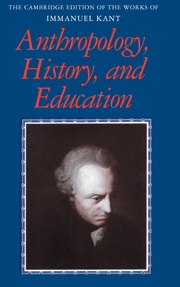Book contents
- Frontmatter
- Contents
- General editors' preface
- Preface
- General introduction
- 1 Observations on the feeling of the beautiful and sublime (1764)
- 2 Essay on the maladies of the head (1764)
- 3 Review of Moscati's work Of the corporeal essential differences between the structure of animals and humans (1771)
- 4 Of the different races of human beings (1775)
- 5 Essays regarding the Philanthropinum (1776/1777)
- 6 A note to physicians (1782)
- 7 Idea for a universal history with a cosmopolitan aim (1784)
- 8 Review of J. G. Herder's Ideas for the philosophy of the history of humanity. Parts 1 and 2 (1785)
- 9 Determination of the concept of a human race (1785)
- 10 Conjectural beginning of human history (1786)
- 11 Some remarks on Ludwig Heinrich Jakob's Examination of Mendelssohn's Morning hours (1786)
- 12 On the philosophers' medicine of the body (1786)
- 13 On the use of teleological principles in philosophy (1788)
- 14 From Soemmerring's On the organ of the soul (1796)
- 15 Anthropology from a pragmatic point of view (1798)
- 16 Postscript to Christian Gottlieb Mielcke's Lithuanian–German and German–Lithuanian dictionary (1800)
- 17 Lectures on pedagogy (1803)
- Editorial notes
- Glossary
- Bibliography
- Index
1 - Observations on the feeling of the beautiful and sublime (1764)
Published online by Cambridge University Press: 05 May 2013
- Frontmatter
- Contents
- General editors' preface
- Preface
- General introduction
- 1 Observations on the feeling of the beautiful and sublime (1764)
- 2 Essay on the maladies of the head (1764)
- 3 Review of Moscati's work Of the corporeal essential differences between the structure of animals and humans (1771)
- 4 Of the different races of human beings (1775)
- 5 Essays regarding the Philanthropinum (1776/1777)
- 6 A note to physicians (1782)
- 7 Idea for a universal history with a cosmopolitan aim (1784)
- 8 Review of J. G. Herder's Ideas for the philosophy of the history of humanity. Parts 1 and 2 (1785)
- 9 Determination of the concept of a human race (1785)
- 10 Conjectural beginning of human history (1786)
- 11 Some remarks on Ludwig Heinrich Jakob's Examination of Mendelssohn's Morning hours (1786)
- 12 On the philosophers' medicine of the body (1786)
- 13 On the use of teleological principles in philosophy (1788)
- 14 From Soemmerring's On the organ of the soul (1796)
- 15 Anthropology from a pragmatic point of view (1798)
- 16 Postscript to Christian Gottlieb Mielcke's Lithuanian–German and German–Lithuanian dictionary (1800)
- 17 Lectures on pedagogy (1803)
- Editorial notes
- Glossary
- Bibliography
- Index
Summary
TRANSLATOR'S INTRODUCTION
Kant's little book Observations on the Feeling of the Beautiful and Sublime was submitted to the Dean of the University of Königsberg for approval of publication on October 8, 1763, and its first edition was published in Königsberg by Johann Jacob Kanter with the date of 1764. Kant's then friend Johann Georg Hamann reported on February 1, 1764 that he was at work on a review of the work (which would appear in the Königsberger gelehrte und politische Zeitungen on April 30, 1764), so the work was actually published no later than January, 1764.
The book was thus written at the end of the period of exceptional productivity in which Kant had composed The False Subtlety of the Four Syllogistic Figures (1762), the Inquiry concerning the Distinctness of the Principles of Natural Theology and Morality (also 1762, although not published until 1764, when it was published by the Berlin Academy of Sciences as the runner-up to Moses Mendelssohn's essay On Evidence in the Metaphysical Sciences, which was awarded the first prize in the Academy's 1762 competition on the question of whether philosophy could employ the mathematical method), the Only Possible Argument in Support of a Demonstration of the Existence of God (1763), and the Attempt to Introduce the Concept of Negative Magnitudes into Philosophy (1763).
- Type
- Chapter
- Information
- Anthropology, History, and Education , pp. 18 - 62Publisher: Cambridge University PressPrint publication year: 2007
- 12
- Cited by

